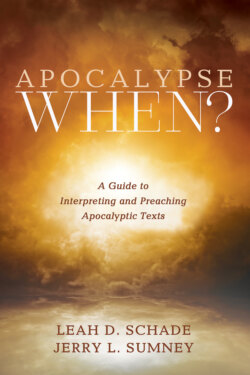Читать книгу Apocalypse When? - Jerry L. Sumney - Страница 5
На сайте Литреса книга снята с продажи.
Preface
ОглавлениеThis book is intended to help the church understand and proclaim the powerful messages that the Bible’s apocalyptic texts contain. Preachers have often been reticent to preach on these texts because they seem too strange or they have been hijacked by people who use them in inappropriate ways. Besides, they also contain some material that seems threatening. But these texts have messages that can strengthen the church’s resolve to be faithful, especially in ways that try to bring God’s justice and love into the world. This may seem like an odd claim because it is sometimes (often) said that these texts encourage people to look only to heaven and a future end-time and so to ignore the things that violate God’s will around them. This understanding of apocalyptic texts substantially misses what the texts want their readers to do. At their core, they want to encourage readers to live faithfully in this world.
This book is a joint effort of a homiletics scholar and a Bible scholar at Lexington Theological Seminary. The first chapter on understanding apocalyptic texts is written by Jerry L. Sumney, the Bible professor. Chapter two on preaching from apocalyptic texts is authored by Leah D. Schade, the homiletics professor. All of the following chapters are divided into three sections. The first section is an exegesis of the text by Sumney. The second and third parts are Ideas for Preaching and a sample sermon. Those two sections are written by Schade. However, we consulted with each other on our sections and worked together on the editing process.
Parts of this book are directly dependent on the early work, Preaching Apocalyptic Texts (St. Louis: Chalice, 1999), that was co-written by Sumney and Larry Paul Jones†, former homiletics professor at Lexington Theological Seminary. His premature passing took a powerful voice from the church. In that previous work, Dr. Jones wrote two sermons for each text for which Sumney wrote the exegesis. The discussion of apocalyptic literature in chapter 1 of the present work is an expansion of a chapter in the previous work, and the exegesis of Daniel 7, Mark 13, and Revelation 14 are slight revisions of the exegesis in it. The exegesis work for 1 Thessalonians 4 and 5 in this work are notable expansions of the exegesis of those texts in the earlier book. None of Schade’s Ideas for Sermons or her sermons depend on Dr. Jones’s homiletical work in that earlier book. We are grateful to Michael Thomson and Cascade Press for seeing the importance of the message of these texts and being willing to include the parts of the book that were previously published.
The present book focuses most of its attention on texts from the Revised Common Lectionary. However, the chapter on Revelation 14 is included because of its oft-misunderstood and misinterpreted imagery and symbolism that has permeated both the church and the larger culture. We hope that this book will provide exegetical and homiletical guidance to enable ministers and others to preach from and teach about these texts. During these challenging and tumultuous times, we trust in God’s power, mercy, and love to strengthen the church and renew hope for the world.
Leah D. Schade
Jerry L. Sumney
